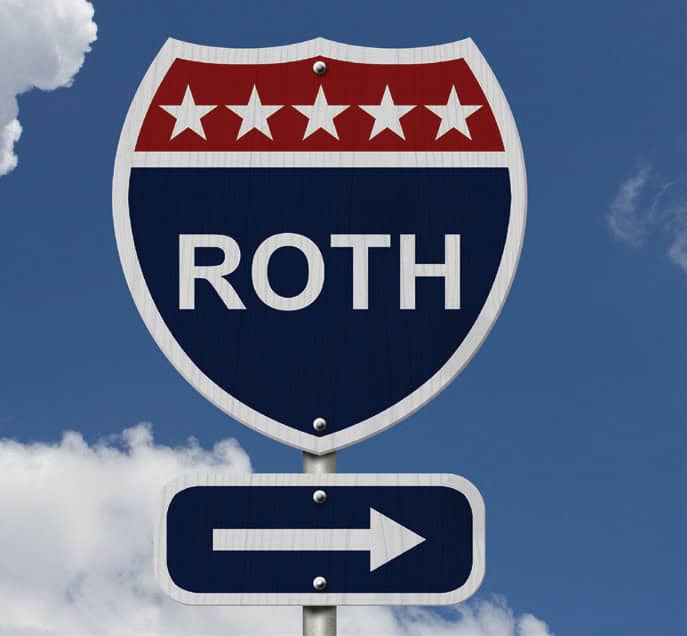Is it a good time for a Roth conversion?

The volatility in the stock market may have caused the value of your retirement account to decrease. But if you have a traditional IRA invested in stocks, a decline may provide a valuable opportunity by allowing you to convert your traditional IRA to a Roth IRA at a lower tax cost.
Traditional vs. Roth
Here are some key differences between these two types of accounts:
Traditional IRA. Contributions to a traditional IRA may be deductible, depending on your modified adjusted gross income (MAGI) and whether you (or your spouse) participate in a qualified retirement plan, such as a 401(k). Funds in the account grow tax-deferred.
However, you generally must pay income tax on withdrawals. You’ll also face a penalty if you withdraw funds before age 59½ — unless you qualify for an exception. And you’ll face an even larger penalty if you don’t take your required minimum distributions (RMDs) when you reach age 72 (73 if you reach age 72 after Dec. 31, 2022).
Roth IRA. Roth IRA contributions aren’t deductible. But withdrawals — including earnings — are tax-free as long as you are age 59½ or older and the account has been open at least five years. Plus, you’re allowed to withdraw contributions at any time tax- and penalty-free and you aren’t subject to RMDs.
However, the ability to contribute to a Roth IRA is subject to limits based on your MAGI. Fortunately, no matter how high your income, you’re eligible to convert a traditional IRA to a Roth, but you’ll have to pay income tax on the amount converted.
Your tax hit may be reduced
If your traditional IRA has lost value, converting to a Roth now instead of waiting could minimize your tax hit. You’ll also avoid tax on future appreciation if the value of your account goes back up.
Before converting, take time to think through the details. Here are some key issues to consider:
Money to pay the tax bill. If you don’t have the cash on hand to cover the taxes owed on the conversion, you may have to dip into your retirement funds, eroding your nest egg. The more money you convert and the higher your tax bracket, the bigger the tax hit.
Your retirement plans. Typically, you wouldn’t convert a traditional IRA to a Roth IRA if you expect to retire soon and will start drawing down on the account right away. Usually, the goal is to allow the funds to grow and compound over time without any tax erosion.
There are also other issues that need to be considered before executing a Roth IRA conversion. If this sounds like something you’re interested in, contact us to discuss whether a conversion is right for you.
Stretch out the tax bill
If the idea of paying the tax bite related to converting from a traditional IRA to a Roth IRA is daunting, consider a gradual conversion. It’s not an all-or-nothing process, so you can stretch out the tax bill over time, depending on how long you expect to wait to retire.
Suppose you have $100,000 in a traditional IRA. You could, for example, convert that in five steps: $20,000 per year for five years. We can estimate what the tax bite will be at varying steps.
The tax obligations if your business closes its doors

Sadly, many businesses have been forced to shut down recently due to the challenges of the economy, including the supply chain. If this is your situation, we can help you meet the various tax responsibilities that go with closing a business.
Of course, a business must file a final income tax return and some other related forms for the year it closes its doors. The type of return to be filed depends on the type of business you have. Here’s a rundown of the basic requirements.
Sole Proprietorships. You’ll need to file the usual Schedule C, “Profit or Loss from Business,” with your individual return for the year you close the business. You may also need to report self-employment tax.
Partnerships. A partnership must file Form 1065, “U.S. Return of Partnership Income,” for the year it closes. You also must report capital gains and losses on Schedule D. Indicate that this is the final return and do the same on Schedule K-1, “Partner’s Share of Income, Deductions, Credits, etc.”
All Corporations. Form 966, “Corporate Dissolution or Liquidation,” must be filed if you adopt a resolution or plan to dissolve a corporation or liquidate any of its stock.
C Corporations. File Form 1120, “U.S. Corporate Income Tax Return,” for the year you close. Report capital gains and losses on Schedule D. Indicate this is the final return.
S Corporations. File Form 1120-S, “U.S. Income Tax Return for an S Corporation,” for the year of closing. Report capital gains and losses on Schedule D. The “final return” box must be checked on Schedule K-1.
All Businesses. Other forms may need to be filed to report sales of business property and asset acquisitions if you sell your business.
Employees and contract workers
If you have employees, you must pay them final wages and compensation owed, make final federal tax deposits and report employment taxes. Failure to withhold or deposit employee income, Social Security and Medicare taxes can result in full personal liability for what’s known as the Trust Fund Recovery Penalty.
If you’ve paid any contractors at least $600 during the calendar year in which you close your business, you must report those payments on Form 1099-NEC, “Nonemployee Compensation.”
Other tax issues
If your business has a retirement plan for employees, you’ll want to terminate the plan and distribute benefits to participants. There are detailed notices, funding, timing and filing requirements that must be met by a terminating plan. There are also complex requirements related to flexible spending accounts, Health Savings Accounts, and other programs for your employees.
We can assist you with many other complicated tax issues related to closing your business, including debt cancellation, use of net operating losses, freeing up any remaining passive activity losses, depreciation recapture, and possible bankruptcy issues.
We can also advise you on the length of time you need to keep business records. You also must cancel your Employer Identification Number (EIN) and close your IRS business account.
If your business is unable to pay all the taxes it owes, we can explain the available payment options to you. Contact us to discuss these issues and get answers to any questions.
Adopting a child? Bring home a tax break too

Two tax benefits are available to offset the expenses of adopting a child. In 2023, adoptive parents may be able to claim a credit against their federal tax for up to $15,950 of “qualified adoption expenses” for each child. That’s a dollar-for-dollar reduction of tax.
Also in 2023, adoptive parents may be able to exclude from gross income up to $15,950 of qualified expenses paid by an employer under an adoption assistance program. Both the credit and the exclusion are phased out if the parents’ income exceeds certain limits.
Parents can claim both a credit and an exclusion for expenses of adopting a child. But they can’t claim both a credit and an exclusion for the same expenses.
Qualified expenses
Only “qualified adoption expenses” are eligible for the adoption credit or exclusion. These are the reasonable and necessary adoption fees, court costs, attorney fees, travel expenses (including meals and lodging), and other expenses directly related to the legal adoption of an “eligible child.”
Not included in qualified expenses are those connected with the adoption of a child of a spouse, a surrogate parenting arrangement, a violation of state or federal law, or the use of funds received from a government program. Expenses reimbursed by an employer don’t qualify for the credit, but as explained above, benefits provided by an employer under an adoption assistance program may qualify for the exclusion. If an adoption attempt is unsuccessful, the related expenses may still qualify, if the child is a U.S. citizen or resident.
Taxpayers who adopt a special needs child can also take a credit or exclusion for $15,950. This is true whether or not they had that amount in actual expenses.
Eligible child
To be eligible, a child must be under age 18 when the expense is paid, though partial deductions may be available if a child turns 18 during the year. Adoptees who are incapable of self-care may qualify regardless of age.
A special needs child is one that a state determines can’t, or shouldn’t, be returned to his or her parent’s home, and due to certain factors, won’t be adoptable without assistance provided to the adoptive family. Only a child who is a citizen or U.S. resident can be included in this category.
Get the full benefit
Contact us with questions. We can help ensure you get the full benefit of the tax savings available to adoptive parents.
Appreciating the helpful balance of bonds

Stock market and interest rate uncertainty may cause some investors to turn to bonds. Perhaps the most “user friendly” bond is a U.S. government savings bond. Buying one means you’re essentially lending the federal government money under certain terms, in exchange for a future return. U.S. savings bonds don’t offer as high a yield as other investment instruments, but they’re highly stable. The amount earned on U.S. government bonds is taxable on federal income tax returns when they’re redeemed, but it’s often exempt on state and local returns. However, you can make a one-time election to report the interest on these bonds each year as it accrues if this is more beneficial.
Another government investment option is a Treasury bill. These are short-term government securities with maturities ranging from a few days to 52 weeks. For a more long-term option, investigate Treasury notes. These government securities are generally issued with maturities of two, three, five, seven and 10 years and pay interest every six months.
If you’re looking to preserve capital while generating some tax-free income, consider a tax-exempt state or municipal bond. Here, you lend money to a more localized government entity in exchange for regular payments. Keep in mind that interest may be taxable on state and local returns.
Corporate bonds are another option. These generally offer a higher yield than their federal or municipal counterparts but come with a greater risk in terms of price fluctuation as markets change and sometimes, issuers default. There are also tax implications, in that interest from corporate bonds is subject to federal, state and local income tax. Plus, as with other types of bonds, you could incur capital gains if you sell the bond at a profit before it matures.
Tax Calendar
June 15 – Second-quarter 2023 estimated tax payments are due for individuals, calendar-year corporations, estates and trusts.
About Batley CPA
Batley CPA, LLC is a full-service CPA firm providing tax, accounting, payroll and advisory services to businesses and individuals throughout Green Bay and the Fox Cities. Batley CPA regularly provides clients with best practices and strategies to maximize cash flow, profit, reduce taxes, manage costs and risk, and bring meaning to financial and operational data. The company has offices in Appleton, Neenah and Green Bay.

